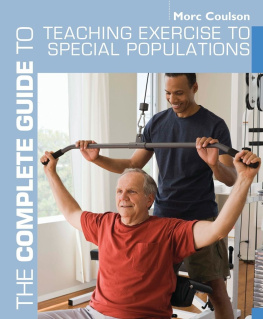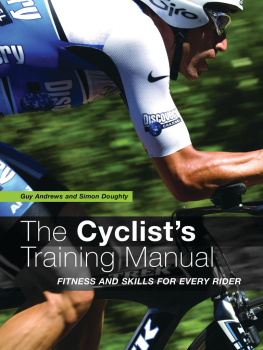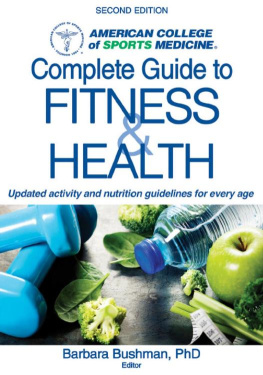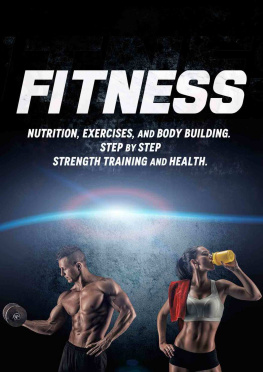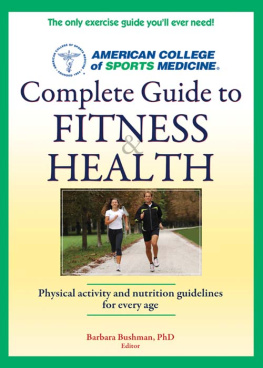
CONTENTS
Knowledge and support have helped many a top athlete over the years, not just physiologically but from a psychological, rehabilitational and medical perspective. It is common for individual athletes to use specifically designed programmes to train at the correct intensity, in the correct frame of mind and with nutritional advice that enables optimum recovery. There are also many recreational health and fitness participants who could benefit in many ways from support given by suitably qualified people. The Fitness Instructors Handbook offers a comprehensive guide to the theory and practical application of health and fitness knowledge, linked closely to national occupational standards in this area. It is hoped that this book might help to develop a culture of education in health and fitness, not just for the benefit of the coach or instructor but for the entire population.
Steve Cram MBE and former BBC TV Sports Personality of the Year
I would like to sincerely thank all who contributed in any way to the development and writing of this book including the editors at Bloomsbury. A big thank you goes out to SkillsActive and REPs for their continuing endeavours in trying to professionalise and bridge the gap between the Health and Fitness industry and academia and to the many training organisations who are actively embracing this philosophy.
This book has been written for a wide audience, such as those who have an interest in health, fitness and sport, or as a reference guide for individuals who, both now and in the future, may be involved in prescribing gym-based cardiovascular and resistance exercise to clients who are referred to as apparently healthy. The main objective of the book is to address the underpinning knowledge requirement related to gym qualifications in the health and fitness industry, and show how that knowledge can be applied in a practical environment. It was a conscious decision to closely relate the book to health and fitness qualification requirements for two main reasons: first, to provide a comprehensive textbook that could help promote the professionalism of the industry and second, to provide a text that comprehensively covers specific health and fitness knowledge criteria that are related to occupational standards.
The chapter topics have been selected to provide a complete coverage of the required knowledge content for the Instructing Exercise and Fitness qualification at Level 2 and the Instructing Physical Activity and Exercise qualification at Level 3 (see Introduction). At the start of each chapter are the criteria related to Level 2 and 3 and the objectives to be addressed. At the end of the chapter you will find revision questions relating only to that particular chapter. Answers to these can be found at the back of the book, with space for revision notes. Each chapter also contains a list of further reading for those who would like to pursue the topic in more depth.
Since 2003 the Government has been committed to the development of the nations skills and in particular the education and training provision to address the nations skills gaps and shortages. In order to facilitate this intention, organisations such as the Fitness Industry Association (FIA) and SkillsActive have taken a lead role.
The FIA was founded in 1991 to drive up participation and address concerns in the industry relating to safety and unfair codes of conduct. The fitness industry has since evolved and matured and, as the representative industry body, the FIA now works closely with Government to help deliver its public health targets and represent the interests of more than 2500 health and fitness organisations across the United Kingdom. FIA members include operators from the public and private sector, service/product suppliers to the industry, training providers, independent professionals and affiliated bodies. Members receive a variety of tailored, business-enhancing products and services specifically designed to support their particular business model or work.
The FIAs primary goal is to get more people more active, more often. This is primarily achieved by developing and running high-profile programmes designed to encourage people who are not regularly active to visit members facilities. The FIA is also working on a regulated Code of Practice to replace its current voluntary Code.
SkillsActive was licensed by government until 2017 as the Sector Skills Council for Active Leisure and Learning. Charged by employers, SkillsActive lead the skills and productivity drive across the sport and recreation, health and fitness, outdoors, playwork, and caravan industries known as the active leisure and learning sector. SkillsActive worked with health and fitness professionals across the United Kingdom to ensure the workforce was appropriately skilled and qualified. This included working with higher and further education to develop qualification frameworks for new qualifications to enable graduates to leave college or university with industry-recognised vocational qualifications. The Register of Exercise Professionals (REPs) has been set up to help safeguard and promote the health and interests of people who are using the services of exercise and fitness instructors, teachers and trainers. REPs use a process of self-regulation that recognises industry-based qualifications, practical competency, and requires fitness professionals to work to a Code of Ethical Practice within the framework of National Occupational Standards that have been developed by SkillsActive. Qualifications needed to gain entry to the Register are closely aligned with National Occupational Standards. Below is an overview of the Level 2 and Level 3 qualification structures that provide entry onto the register.
Note: There is a Level 4 but the knowledge specific to this is not covered within this book.
Level 2 Instructing Exercise and Fitness
There are various categories from which to gain entry to Level 2 of the exercise register. Instructors may hold one or more of these categories. In order to gain an award at this level, individuals must successfully complete the mandatory units and one or more of the paired optional units as shown below. Individuals must also show competence in the core exercise and fitness knowledge criteria required at this level.
Note: Instructors must successfully complete all of the mandatory units below.
Level 2 Mandatory Units |
SKAEF1 | Health, safety and welfare promotion in active leisure and recreation. |
SKAEF2 | Assist participants to develop and maintain the motivation to adhere to exercise and physical activity. |
Note: Instructors may hold one or more optional units.
Level 2 Optional Units |
Gym |
SKAEF3 SKAEF4 | Plan and prepare gym-based exercise. Instruct and supervise gym-based exercise. |
Exercise |
SKAEF5 SKAEF6 | Plan and prepare group exercise. Instruct group exercise. |
Exercise, Music and Dance |
SKAEF7 SKAEF8 | Plan and prepare group exercise, movement and dance. Instruct group exercise, for exercise, movement and dance. |
Aqua |
SKAEF9 SKAEF10 | Plan and prepare water-based exercise. Instruct water-based exercise. |
Exercise and Physical Activity for Children |
SKAEF11 SKAEF12 | Plan health-related exercise and physical activity for children. |
Next page

